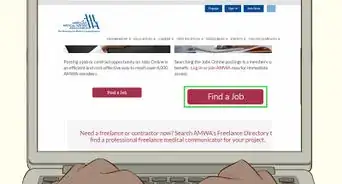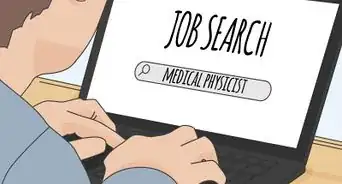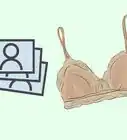This article was co-authored by wikiHow Staff. Our trained team of editors and researchers validate articles for accuracy and comprehensiveness. wikiHow's Content Management Team carefully monitors the work from our editorial staff to ensure that each article is backed by trusted research and meets our high quality standards.
There are 12 references cited in this article, which can be found at the bottom of the page.
This article has been viewed 46,398 times.
Learn more...
Medical billers are professionals who translate a healthcare service into a billing claim for you or your insurance company. You may be considering a career in this exciting field, which can optimize revenue for a doctor’s office or practice.[1] Because people are always going to the doctor it means that you not only have great job prospects, but also would allow you to work with doctors, patients, and different companies. However, you may be unsure how to pursue this career path. By getting certified and practical experience and then pursuing different jobs, you can become a certified medical biller.
Steps
Getting Certified and Practical Experience
-
1Recognize your options. You don’t need certification to work as a medical biller. However, it’s a good idea to consider getting certification through independent organizations or one of the two primary medical billing organizations, the American Health Information Management Association (AHIMA), the American Medical Billing Association (AMBA), or the American Academy of Professional Coders.[2] Not only will these programs give you the necessary education to be a medical biller, but they also offer courses to make you a more thorough and effective medical biller. This may translate to a better job for you.
- Consider getting certified with one of the two primary national programs, which offer courses on being a medical biller, but supporting courses on being a medical coder, computer codes, and business practices.[3]
- Be aware that many community and technical colleges and universities offer 2 or 4 year programs to be a certified medical biller. Meet with an admissions professional to discuss your options and see if the medical billing course ends with certification through one of the national organizations. In many cases, these degree programs will prepare you to sit for one of the national certification exams.[4]
-
2Obtain required education. At a minimum, you need a high school diploma or GED to be a medical biller. Some programs, such as AAPC, require an associate’s degree and coursework in anatomy, physiology, or other related fields. Finally, you may also need vocational training to get your certification.[5]
- Figure out the type of medical billing you want to do. If you want to simply create medical bills, you can enroll in online programs such as AHIMA and AAPC. However, if you would like to work in a variety of environments such as a hospital or doctor’s office, you will need more education that is also available from these organizations as well as local colleges and technical schools.[6]
- Enroll in any required courses and consider adding classes that will boost your basic knowledge. Be aware that the more classes you take, the more it will cost you. Consider applying for what you can afford and boosting your education as you can afford it.[7]
Advertisement -
3Register for a certification program. Consider the different program options including independent certification programs and recognized programs such as AAPC or AHIMA. Each program has different education and certification requirements, but they are generally made up of the basic components of education and a certification examination. Review each program’s features to see which best suits your wishes and needs for being a medical biller. Consider factors including cost and the timeframe for obtaining certification..[8]
- Enroll in a certification program either at the AAPC or AHIMA websites. These can also point you to affiliated programs in your area.
- Provide any information necessary to enroll. This generally includes your personal information, educational and professional background, and anything else that may be relevant to your desire to be a medical biller. You may also need to become a member of the certifying organization. Finally, pay any course fees required by the program.[9]
-
4Fulfill education requirements. After you’ve registered for an education and certification program, you must meet education requirements such as coursework and participating in webinars in order to take the certification exam. Your coursework helps you not only pass the certification exam, but also optimally perform your duties as a medical biller.[10]
- Follow the coursework requirements detailed in your education packet. In general, these include elements such as assigning proper medical codes for specific diagnoses and procedures performed by doctors, proficiency with a broad range of services including management and anesthesia, knowledge of medical coding guidelines and regulations, knowing how to integrate coding and payment changes into an existing system, and knowledge of the terminology used in a medical office.
-
5Do an internship. Some programs may require practical experience as a part of their education program. If yours doesn’t, consider doing an internship or working in a medical office to gain practical experience that can boost your education and help you pass the certification exam. In addition, an internship may open to the door for you to future employment.
- Speak to a career counselor, local doctor’s office, or draw on a professional network about getting practical experience. Ask about the best types of work for your specific education and certification goals.
- Be aware that many organizations consider two years experience as a medical biller necessary to pass the certification exam.[11]
-
6Submit an application for certification. Once you’ve finished your education and pre-certification requirements, submit an application to your certifying organization to take the certification exam. Check your organization's website to get exact application requirements.[12]
- Schedule an exam date from the options in your area. Remember that you must attend an exam with a proctor at a physical location.
- Obtain any letters of recommendation and employer verification you need to take the exam.
- Pay any additional fees necessary to sit the exam.
-
7Prepare for your certification exam. Once you’ve applied to take the certification exam, you’ll need to take it to obtain your medical biller certification. You should study before the exam to improve your chances of passing on the first try.[13]
- Meet with classmates or attend organizations’ local chapter meetings to meet people with whom you can study. You may find you learn more by studying as a group than if you study alone.
- Use the most recent coding books to study for the exam. These resources are updated every year and not using the proper volume may hinder your ability to pass. Make sure to study a variety of topics for your exam. Many exams will have questions on the following fields: anatomy, medical terminology, information technology and computers, coding, insurance, fraud and abuse, compliance and health laws.
-
8Take the certification exam. In most cases, you will take the exam at a designated location, but some programs may allow you to take the certification examination online. After scheduling the exam date and preparing yourself, sit the exam at a time you feel comfortable. Make sure you pay any fees up front so that you can enter the job market as quickly as possible.[14]
- Verify any examination information you receive from the certification organization. You may receive this electronically or by mail. Make sure to note the name of your proctor and phone number to verify examination information.
- Get your exam results between 7-10 days after you sit the exam. Results are generally available online and by mail.
- Be aware of policies if you fail the exam. Some organization will require you to pay a fee each time you take the exam. You may also need to wait for a specific period of time between exams.
-
9Update your certification. Depending on your certifying organization, you will need to recertify your skills every few years. This helps you stay on top of coding developments and trends and maintain your professional appearance.[15]
- Consider recertification requirements when you start your education and certification process. You’ll generally need a certain number of continuing education units to get your recertification. You may also need further coursework.
- Provide any documentation and pay any fees needed for recertification. You may need to show the following information: coding self-assessments, proof of obtaining continuing education credits, participation in accepted and qualified continuing education programs, and proof of payment of fees.
Finding Work
-
1Apply for jobs. As a certified medical biller, you have the option of working in different professional environments. Depending on your preferences and experience, you could work in a hospital, doctor’s office or with another healthcare provider.
- Send letters of intent to local employers about your interest in working for them and your credentials. For example, contact local hospitals and inquire if they are looking for someone with your certification and skills.
- Ask fellow medical billers in your local area if they know of any job opportunities.
- Check the websites of professional organizations such as AMBA, AAPC, and AHIMA for job listings.[16]
- Register yourself with a headhunter or placement agency to help find opportunities as a medical biller.
-
2Be a volunteer. If you’re recently certified and looking for a job, consider volunteering during your down time. Choose a hospital, doctor’s office, or another facility where you think you might like to work. This can help you build your network of colleagues and may also alert you to job opportunities more quickly.
- Consider volunteering as a way to gain valuable practical experience and make inroads in the medical billing profession. Remember that it will also look good on your resume.
-
3Network with other billing professionals. Meeting other medical billers can expand your knowledge of the profession and help you find work. Attend workshops, local chapter meetings, and national conferences whenever you get the chance.[17]
- Join local and national medical biller organizations such as AMBA, AAPC, and AHIMA. These organizations have local chapters, regular meetings, national conferences, and events where you can meet other certified medical billers.
Considering a Career as a Medical Biller
-
1Inform yourself about medical billing. If you want a career in medicine, but don’t want to be a doctor, consider working as a medical biller. Helping a medical facility run smoothly can be very rewarding. It allows you to work with doctors, patients, and others such as insurance companies.[18]
- Providing assistance can be very rewarding not only for you, but also to the people whom your work supports.
- Be aware that medical coding may have some emotional demands. You might have to bill for serious conditions such as cancer or death. This could upset you. You may also have to positively maneuver dynamics or situations involving patients, medical professionals, and insurance companies. If you like working with and helping people, then a working as a medical biller might be a great option for you.
-
2Ensure you meet basic requirements. You’ll need special education and training to be a certified medical biller. Seeing if you meet basic education requirements and have the right personality traits can help you figure out if this is the right path for you.
- Consider shadowing a medical biller for a day so that you can get a better sense of what a typical working day entails. Make sure to ask questions about the person’s career path and any things they like and dislike about the profession.
- Be aware that you’ll need at least a high school diploma or GED to enroll in a course. You’ll need further education and practical experience to get certification.
-
3Ask how the career fits your lifestyle. Being a medical biller can be very rewarding, but also has demands such as sitting for long hours and deciphering bad handwriting. Figuring out if you can take this career path and maintain your lifestyle may help you decide on what type of certification you want. Ask yourself some of the following questions:[19]
- What are the possible physical demands? You might need to work late at night, stare at computer screens for long hours, or sit for hours at a time.
- Does medical billing fit my personality? Working with doctors, insurance companies, and patients is a big part of being a medical biller. This could be a good option for you if you like working with people and in the medical profession.
- How does medical billing fit my lifestyle? Medical billers are necessary for any healthcare or medical facility and, in many cases, you may be able to set your hours according to your schedule. You may need to work more at times of high need but will also get perks like vacation time.
- Will I make enough money? Medical billing is a quickly growing profession and this means you shouldn’t have a hard time finding a job. Currently, the average salary of medical billers in the United States is $34,000.[20] Depending on the facility in which you work, you may also get health benefits in addition to your salary.
References
- ↑ https://www.aapc.com/medical-billing/medical-billing.aspx
- ↑ http://www.medicalbillingandcoding.org/qnas/how-long-does-it-take-to-complete-training-to-become-a-medical-biller-or-coder/
- ↑ https://www.aapc.com/medical-billing/medical-billing.aspx
- ↑ http://www.medicalbillingandcoding.org/qnas/how-long-does-it-take-to-complete-training-to-become-a-medical-biller-or-coder/
- ↑ http://www.medicalbillingandcoding.org/qnas/what-are-the-medical-coding-certification-requirements/
- ↑ http://www.medicalbillingandcoding.org/qnas/how-long-does-it-take-to-complete-training-to-become-a-medical-biller-or-coder/
- ↑ https://www.aapc.com/training/cpc-complete-training-package.aspx
- ↑ http://www.medicalbillingandcoding.org/qnas/how-long-does-it-take-to-complete-training-to-become-a-medical-biller-or-coder/
- ↑ https://www.aapc.com/shopping/cart.aspx
- ↑ http://www.ahima.org/certification/whycertify
- ↑ https://www.aapc.com/certification/faq.aspx
- ↑ https://www.aapc.com/certification/locate-examination.aspx
- ↑ https://www.aapc.com/certification/faq.aspx
- ↑ https://www.aapc.com/certification/faq.aspx
- ↑ http://www.ahima.org/certification/Recertification
- ↑ https://www.aapc.com/medical-coding-jobs/
- ↑ https://www.aapc.com/resources/events.aspx
- ↑ http://www.medicalbillingandcoding.org/qnas/what-are-the-medical-coding-certification-requirements/
- ↑ http://www.medicalbillingandcoding.org/qnas/what-are-the-medical-coding-certification-requirements/
- ↑ http://www.medicalbillingandcoding.org/working-in-mbac/










































































